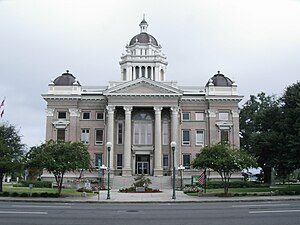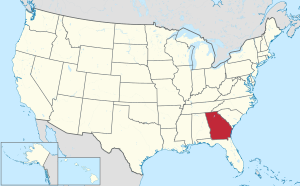
Madison County is a county located in the north central portion of the state of Florida, and borders the state of Georgia to the north. As of the 2020 census, the population was 17,968. Its county seat is also called Madison.

Thomas County is a county located in the U.S. state of Georgia. As of the 2020 census the population was 45,798. The county seat is Thomasville. Thomas County comprises the Thomasville, GA micropolitan statistical area.
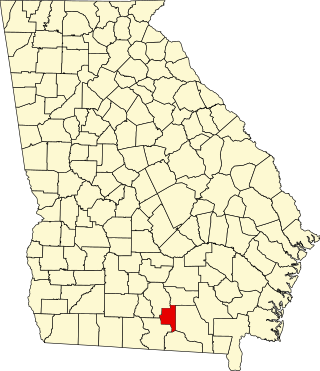
Lanier County is a county in the south central portion of the U.S. state of Georgia. At the 2020 census, the population was 9,877. The county seat is Lakeland. It is named after Georgia poet Sidney Lanier.

Irwin County is a county located in the U.S. state of Georgia. As of the 2020 census, the population was 9,666. The county seat is Ocilla. The county was created on December 15, 1818. It was named for Governor Jared Irwin.

Early County is a county located on the southwest border of the U.S. state of Georgia. As of the 2020 census, the population was 10,854. The county seat is Blakely, where the Early County Courthouse is located. Created on December 15, 1818, it was named for Peter Early, 28th Governor of Georgia. The county is bordered on the west by the Chattahoochee River, forming the border with Alabama.

Echols County is a county located in the southeastern part of the U.S. state of Georgia. As of the 2020 census, the population was 3,697. The county seat is Statenville. Since 2008, Statenville is a disincorporated municipality. Echols and Webster counties are the only two counties in Georgia to currently have no incorporated municipalities. The county was established in 1858 and named in honor of Robert Milner Echols (1798–1847).

Cook County is a county located in the south central portion of the U.S. state of Georgia. As of the 2020 census, the population was 17,229. The county seat is Adel. The constitutional amendment to create the county was proposed July 30, 1918, and ratified November 5, 1918. It is named for former Civil War general Philip Cook of the Confederate States Army.

Brooks County is a county located in the U.S. state of Georgia, on its southern border with Florida. As of the 2020 census, the population was 16,301. The county seat is Quitman. The county was created in 1858 from portions of Lowndes and Thomas counties by an act of the Georgia General Assembly and was named for pro-slavery U.S. Representative Preston Brooks, after he severely beat abolitionist Senator Charles Sumner with a cane for delivering a speech attacking slavery.

Berrien County is a county located in the south central portion of the U.S. state of Georgia. As of the 2020 census, the population was 18,160. The county seat is Nashville. The county was created February 25, 1856, out of portions of Coffee, Irwin and Lowndes counties by an act of the Georgia General Assembly. It is named after Georgia senator John M. Berrien.
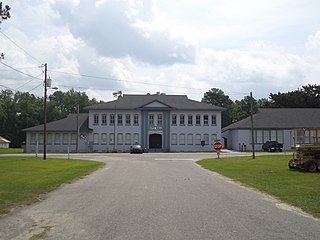
Morven is a city in Brooks County, Georgia, United States. It is part of the Valdosta metropolitan statistical area. The city was named after a mountain in Scotland. The population was 565 at the 2010 census, and 506 in 2020. It was formerly known as Sharpe's Store.

Homerville is a city and the county seat of Clinch County, Georgia, United States. Its population was 2,456 at the 2010 census, a decrease of 12.38% from 2,803 in 2000. It was incorporated February 15, 1869.

Lakeland is a city and the county seat of Lanier County, Georgia, United States. The city is the county seat of Lanier County. It is part of the Valdosta, Georgia metropolitan statistical area. The population was 2,875 at the 2020 census.

Lake Park is a city in Lowndes County, Georgia, United States. The population was 932 in 2020, up from 733 in 2010.
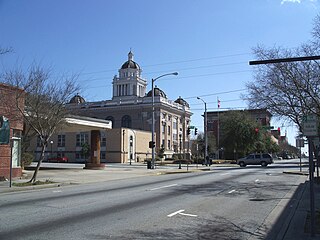
Valdosta is a city in and the county seat of Lowndes County in the U.S. state of Georgia. As the principal city of the Valdosta metropolitan statistical area, which in 2023 had a metropolitan population of 151,118, according to the US Census Bureau its metropolitan area includes Brooks County to the west. With a city population of 55,378 in 2020, Valdosta is the home of Valdosta State University, a regional university in the University System of Georgia with over 12,000 students as of 2021.
"Troupville" is an extinct unincorporated community in Lowndes County, Georgia, United States, near Valdosta. Troupville was a riverboat landing near the confluence of the Withlacoochee River and the Little River at the uppermost navigable point. It was the third county seat of Lowndes County. Troupville was named after Governor George Troup.

The Atlantic and Gulf Railroad was chartered in February 1856 by act of the Georgia General Assembly. It was also known as the Main Trunk Railroad. It traversed south Georgia from Screven to Bainbridge, Georgia. Construction began in early January 1859. Its construction was halted by the American Civil War. Construction began again after the end of the war and the line was completed to Bainbridge, Georgia by late December 1867. The route never reached all the way to the Gulf of Mexico as it had originally intended. The company went bankrupt in 1877 and was bought in 1879 by Henry B. Plant and became incorporated into his Plant System. Its main line is currently operated by CSX Transportation. Throughout its history, the Atlantic and Gulf was closely associated with the Savannah and Albany Railroad Company and its successor the Savannah, Albany, and Gulf Railroad.

Clyattville is an unincorporated community and census-designated place (CDP) in Lowndes County, Georgia, United States. It was established in the 1840s.

The Valdosta metropolitan area, designated the Valdosta metropolitan statistical area by the U.S. Office of Management and Budget, is a metropolitan statistical area consisting of four counties—Brooks, Echols, Lanier, and Lowndes—centered on the city of Valdosta. Located in Southeast Georgia, the metropolitan area's population was 151,118 according to 2023 U.S. census estimates, up from 149,849 at the 2020 U.S. census.
On May 16, 1918, a plantation owner was murdered, prompting a manhunt which resulted in a series of lynchings in May 1918 in southern Georgia, United States. White people killed at least 13 black people during the next two weeks. Among those killed were Hazel "Hayes" Turner and his wife, Mary Turner. Hayes was killed on May 18, and the next day, his pregnant wife Mary was strung up by her feet, doused with gasoline and oil then set on fire. Mary's unborn child was cut from her abdomen and stomped to death. Her body was then repeatedly shot. No one was ever convicted of her lynching.

Southeast Georgia is an eighteen-county region within the U.S. state of Georgia, bordering Florida. The region includes a portion of Georgia's Lower Coastal Plain. Southeast Georgia's largest city is Valdosta, which forms the core of the Valdosta metropolitan area. The region's largest county by population is Lowndes County, of which Valdosta is the county seat. The region had a total resident population of 416,498 in 2020. Largest cities in the region: Valdosta, Tifton, Waycross, Douglas, Fitzgerald.
